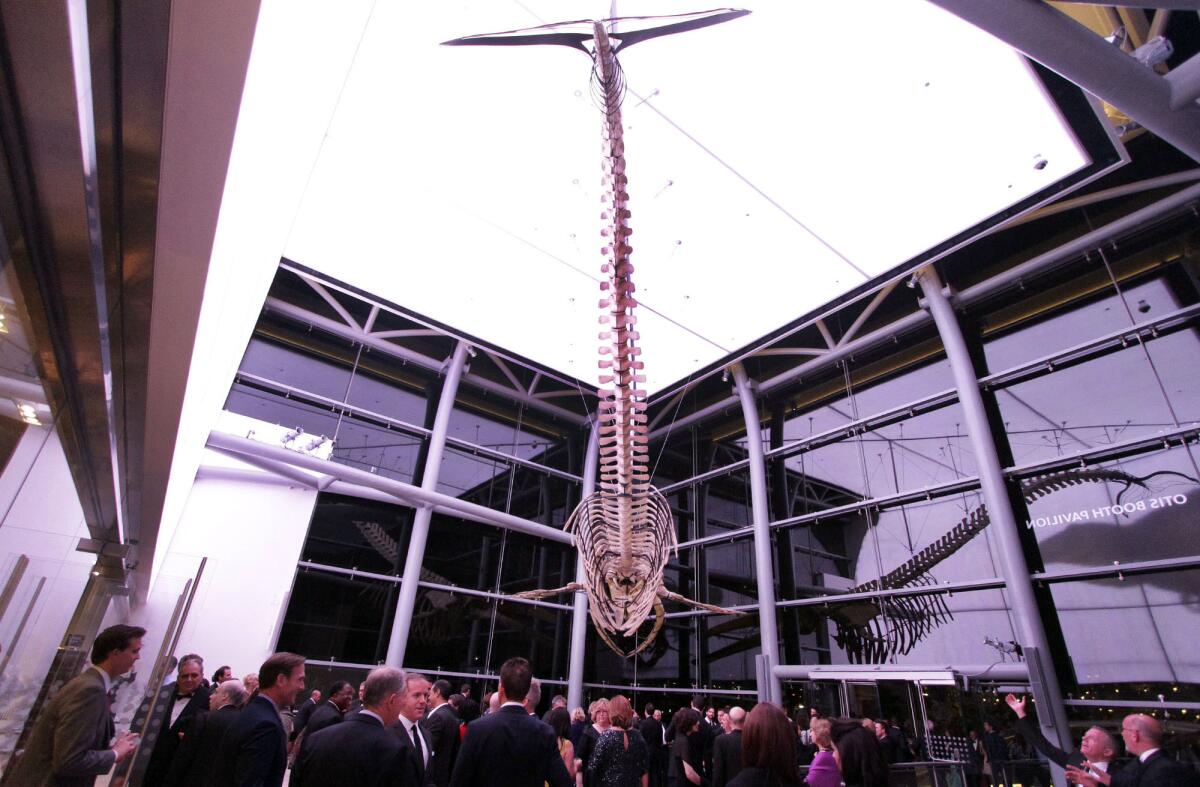Natural History Museum’s Otis Booth Pavilion finally revealed

- Share via
The 100-year-old Natural History Museum of Los Angeles County knows how to make an entrance.
On Saturday night, following a black-tie dinner to celebrate its centennial, the museum lifted the curtain on its brand-new entrance, the Otis Booth Pavilion.
The $13-million structure is a six-story-high, multimedia-infused glass cube that’s now home to the museum’s famous fin-whale skeleton, which hangs in a diving position from the ceiling. Until now, the building has been under wraps, with mystery mounting as to what shape it was taking under its tightly fitted white tent.
PHOTOS: Natural History Museum’s evolution
More than 1,000 people gathered, cocktails in hand, for the big reveal, which the museum milked for every bit of drama it could. A marching band, led by “Hunter” the T. rex and “Dakota” the triceratops, lumbered across the pavilion’s new pedestrian bridge, kicking off the festivities.
A half-hour light show, projected onto the face of the still-tented pavilion, followed. It included birthday wishes from prominent local arts and political figures — the Los Angeles Philharmonic’s Deborah Borda, county Supervisor Zev Yaroslavsky and “Seinfeld’s” Jason Alexander among them – as well as a dramatic photo montage of the museum through the decades and snippets from television shows and films shot at the museum.
But even “Mad Men,” “Bones” and Matthew Broderick’s famous Honda commercial couldn’t compete with the drama that came next.
GRAPHIC: Tour the revived Natural History Museum
First, a whale in a tank was projected onto the front of the building – it swooshed in circles, restless. Then real steam shot up from the roof of the Otis Booth Pavilion, as if coming from the whale’s spout.
Inside this “tank,” the whale threw itself against the side of the glass until the glass cracked and the force of the now-violently choppy water shattered the tank. In the midst of all this, the real-life curtain over the pavilion fell, rippling on its way to the ground as if it was a splash of white sea foam.
At this, the crowd — most in evening gowns and tuxes — let out a collective, cacophonous cheer. There was thunderous clapping, joyous hollering. A DJ started playing in the distance. Then the crowd flooded across the bridge into the officially open Otis Booth Pavilion, now glowing with more than 33,000 multicolored LED bulbs.
“I’m a little overwhelmed, frankly,” yelled lead architect Fabian Kremkus over the music. “But I’m thrilled. This will be the first real public amenity open to the community in this area. That’s the great thing about it.”
The pavilion, which faces Exposition Boulevard and the light-rail Expo Line, opens onto 3½ acres of new nature gardens. That’s where the drama will continue Sunday, with a day-to-night celebration that includes workshops, lectures and an evening concert featuring Devo and GZA/The Genius.
ALSO:
Natural History Museum is set to dive into L.A.’s scene
Review: ‘Rite’ stuff for Bad Plus at the Ojai Music Festival
Sunnylands presidential summit spotlights estate’s public mission
More to Read
The biggest entertainment stories
Get our big stories about Hollywood, film, television, music, arts, culture and more right in your inbox as soon as they publish.
You may occasionally receive promotional content from the Los Angeles Times.











